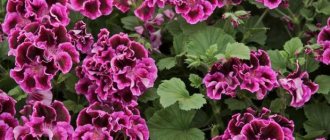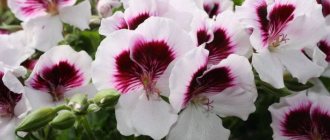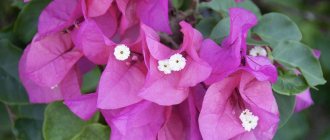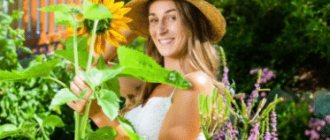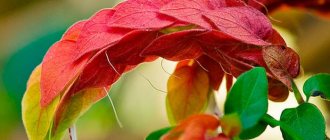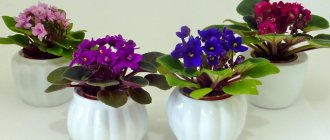Features of the view
The height of dwarf geranium ranges from 12.5–20 cm. This variety belongs to the beautifully flowering type. Thanks to the efforts of breeders, there are many varieties with a wide variety of petal colors. Flowering is usually long and lush.
Most often, dwarf pelargonium does not need shaping pruning, since it forms a neat bush on its own - this is very convenient for busy owners. However, please note: contrary to popular misconception, this property is not inherent in all dwarf varieties.
This plant looks stylish and noble both in an apartment and in an office interior. Well suited for landscaping balconies and verandas.
Varietal Pelargonium Rooted cuttings.
- Log in to reply to this topic
#1041
Post edited by Dashets: 03.11.2014, 08:12:06
- Top
#1042
I'm adding to the list. PAC Viva Madeleine-2500
New. The flowers are double, very large, creamy white with green and a pinkish glow from the inside. The leaves are green. The bush is very compact, I would even say dwarf. The bloom is incredible. It doesn't grow at all, it just blooms and blooms.
- Top
#1043
Adding to the main list!!
PAC Lilac Rose -1600 cuttings
compact ivy-leaved pelargonium from the German company Elsner pak Jungpflanzen. Another variety is rosebud. Ampel is distinguished by its most abundant flowering. The inflorescences are bouquets of fairly large pink-purple flowers of a pink shape. Stunningly beautiful variety! And, from my point of view, the most lilac-blue. No one else has this shade.
- Top
#1044
- Top
#1045
- Top
#1046
Post edited by Dashets: 05.11.2014, 12:34:08
- Top
#1047
Post edited by Dashets: 06.11.2014, 07:52:03
- Top
#1048
- Top
#1049
- Top
#1050
- Top
#1051
- Top
#1052
- Top
#1053
- Top
#1054
- Top
#1055
- Top
#1056
- Top
#1057
- Top
#1058
- Top
#1059
I add. MILLFIELD ROSE single cuttings 1700 tenge This beauty does not need advertising, everyone already knows and wants it. Pelargonium from the Ivy-hybrids group. Flowers with rose-shaped petals of soft pink color. The inflorescence is very large and dense. A very beautiful, completely unpretentious variety to care for. Blooms profusely and often. Disadvantage: difficult to root. The bush forms fluffy and wide. Doesn't like droughts. Otherwise, this is real luxury.
- Top
The best varieties
Let's look at the most popular varieties of dwarf pelargonium.
- Pink Ice. The bush is branched, strong and dense. Double flowers. The petals are quite long, soft pink in color, with a gradual lightening towards the edge. Cases have been recorded when one red flower could appear among the pink ones. Pink Ice is similar in many ways to the Natalie variety, but unlike it does not cause any problems with shaping. May be a little littered with petals.
- Jinky. The flowers are large, double, and form lush caps. The petals are pinkish-peach, sometimes with a cream tint. Closer to the core the color is especially rich. Flowering is long and abundant. The bush is airy and neat. The leaves are golden-green, often with an inner dark circle, giving them a special decorative appearance. Resistant to yellowing.
- Madame Salleron. This variety is valued primarily for its decorative gray-green leaves with a wide creamy-white border. The petioles are thin. The bush is very lush and does not emit the characteristic smell of geraniums. It blooms extremely rarely, with simple bright pink flowers. Bred in 1877
- Silk Moira. The inflorescences are dense, densely double, forming caps. The petals can be apricot or pale salmon. The top ones are usually a little darker. The leaves are golden green. The bush is compact, with short internodes, and grows quickly. Zoning on the leaves is weakly expressed, but in bright sun it can become noticeable.
- Clatterbridge. Pelargonium is a zonal type with a fluffy and dense bush. The flowers are densely double, fiery scarlet, and do not litter with petals. Collected in caps 9–10 cm in diameter. In bright sunshine, the petals acquire a crimson hue over time. Flowering is abundant and long. The leaves are small, the internodes are short.
- Pac Harmony. The flowers are semi-double, quite large (from 5 cm), juicy dark pink, lighter near the core. Owners of this flower unanimously note the early and extremely abundant and long “uncontrollable” flowering. Even a young bush quickly grows a large number of large inflorescences. The variety readily bushes and grows wider than tall. The foliage is scalloped and attractive.
- Deacon Suntan. The flowers are semi-double, bright orange, with a lighter underside and a white center. Collected in dense inflorescences, almost the size of a palm. The caps look especially large compared to the compact bush - according to reviews, sometimes they can even outweigh, causing the pot to fall. Flowering is long. The plant begins to throw out inflorescences at a young age. The shoots grow slowly, the bush sometimes remains at the miniature level (less than 12.5 cm), and not dwarf.
- Dylan Cherone. The flowers are speckled, double, with a pink or lilac-white background and burgundy markings. With plenty of light and fresh air, the shades become more saturated and the specks become brighter. Flowering is abundant, flower stalks are formed from almost every leaf axil.
- Marie Louise. The variety is distinguished by the unusual shape of the flowers: they do not open completely, which is why they resemble tulips. The decorative effect of the flowers is enhanced by the wavy edge. The petals are light peach with a transition to cream, sometimes salmon. There is a light border. The bush grows quite slowly.
- Diana Palmer. Geranium of zonal type. The flowers are semi-double, pastel orange, shaped like carnations. Quite large (4–4.5 cm). Flowering begins early, sometimes barely rooted cuttings are already forming buds. The variety does not bush on its own and requires pinching. The bush is relatively large. Leaves stop growing after flowering begins.
Growing rules
In order for geranium to delight with lush, abundant flowering, it is important to create comfortable conditions for it.
Like other varieties, dwarf pelargonium needs plenty of light: without it, the foliage and flowers turn pale, the sprouts become disproportionately elongated, and the leaves become smaller. The optimal place for growing will be a south window. It is desirable that the light be diffused, but direct sunlight for several hours a day is also allowed. However, if the leaves begin to turn yellow and dry, the flower needs to be moved to more gentle conditions. In winter, additional lighting is desirable: the optimal daylight hours for this plant is 16 hours.
It is important to maintain a balance of watering. On the one hand, in warm weather it should be plentiful and regular; on the other hand, the roots of pelargonium react very painfully to stagnant water, so it is important that the soil is loose, well-permeable to moisture and air.
When watering, water should not fall on the leaves. Air humidity does not matter for geraniums. You cannot spray it. In winter, watering is reduced by half.
'Minca'
'Minca'
Post by IrinaS » July 23, 2022, 6:19 pm
The first flowering was like this
then this
'Minca'
Post by Lyudmila Pivovarova » July 23, 2022, 11:07 pm
'Minca'
Post by IrinaS » July 24, 2022, 8:57 pm
'Minca'
Post by IrinaS » 11 Aug 2022, 19:23
'Minca'
Post by Olga55 » 14 Aug 2022, 07:22
'Minca'
Post by IrinaS » 14 Aug 2022, 15:07
'Minca'
Post by IrinaS » 17 Sep 2022, 18:27
'Minca'
Post by Olga55 » 17 Sep 2022, 20:55
'Minca'
Post by marinka » 26 Feb 2022, 13:05
'Minca'
Post by Pepino » 01 Mar 2022, 12:05
The flowers are small, very small for my taste, although they have a beautiful shape and color. Mine were no more than 3 cm. In the photo with the Deacon Gala flower.
'Minca'
Post by Svetik-ok » Mar 29, 2022, 5:09 pm
I will also share my impressions about this variety. I've had it for a year, but I already have a lot of emotions from communicating with this variety. From the excitement of anticipation, disappointment and fascination. I purchased a cutting from Irina from Kazan. Nice, fluffy. I transplanted it into a larger pot, and it started.
This girl grew strangely - at each point of growth it forked, or even produced three shoots, new leaves were deformed. I even wrote to Irina with a bunch of questions about how to deal with this variety: “A bunch of small leaves have grown, about 8 growing points. And it turns out that the whole bush is covered with this little thing and is not growing. My thoughts on this matter: it is necessary to thin out, remove some growth points so that the strength goes to the remaining ones; or perhaps this is the nature of growth when there are a lot of leaves and it grows slowly (and I’m expecting fast growth); Well, maybe this variety has some features that I wanted to ask you about. Yes, the shape of its leaf blade is also different from ordinary varieties, as it seemed to me.” Irina answered me: “Svetlana. Good evening! The variety is new to many, including me. The specifics of growth are like this. But I recently decided to straighten it, leaving the largest branches - They, of course, also fork. But this is its specificity. The flowers are very beautiful. This is what attracts the variety. But you have to try to please.” I pleased this peculiar girl in every possible way, and she thanked me with a gorgeous flower. What is possible for this little girl. As Pepino wrote above, the flowers are really small, 2-3 cm, but the bush is also small. Over the spring and summer it grew 20 centimeters in height. Moreover, I didn’t pinch her, I gave her complete freedom, and fed her like everyone else.
Unfortunately, only this photograph of the flowering remains. Yes, now, in the spring, after pruning, my Minca is also overgrown - small deformed leaves, several growth points from one.
Beautiful bush of pelargonium (geranium) +14 photos
I purchased a bag of seeds for 50 rubles at a regular country seed store.
only 4 grains in the package
But it doesn’t matter, I thought, because pelargoniums have excellent germination rate, about 90-95% .
Which, according to my calculations, guaranteed me at least 3 plants.
But here I was wrong...
Planting the seeds of pelargonium Night Salmon took place as usual in a small container; the seeds are laid out on moist soil.
The distance between them is approximately 5 cm.
Seeds lightly! cover with earth. The entire container should be covered with film or glass, creating a kind of greenhouse.
Shoots should appear in 2 to 4 weeks.
This time (and I have a lot of experience in planting and growing), germination turned out to be poor. Only 1 seed sprouted.
Of course, I protected the sprout with special care. And finally, it turned out to be an adult plant that bloomed.
At the 2nd year of life of this bush (when the lower trunks were exposed), the bush was cut off.
And now, finally, I have a lot of them)))
The color is very beautiful. Something between pink and orange. I guess you could say salmon. Along the edge of the flower the tone is lighter, almost white.
The leaves have an unusual color compared to other varieties of geranium. The middle of the leaf is dark, and the edge of the leaf is the usual green color.
The brighter the color of the leaf, the sunnier the window sill you choose.
On windowsills without sun (but with enough light, otherwise the plant simply will not survive), the leaves will have the usual green color and will not differ in any way from other varieties.
The seed package stated that the plant was 35 cm tall.
In fact, the bush is 35-40 cm + also the height of the peduncles, which makes it more than 35 in flowering form.
Pelargonium catalogue: Mini
Miniature double pelargonium with disproportionately large flowers. Plant height is 15 cm. I liked the delicate pink-coral shade with transitions, very long flowering, leisurely growth.
Zonal miniature terry pelargonium. Rich dark wine shade of flowers. Very cute pelargonium!
Miniature zonal double pelargonium. Abundant flowering of very large double coral flowers. An adult plant reaches 15cm.
Miniature semi-double zonal pelargonium. Bright flowers on golden foliage. Variety perfection! Would look great solo. Participated in the exhibition in July 2022.
Terry miniature zonal pelargonium. Flowering is very abundant. Fluffy bush! The flowers are bright red.
Zonal miniature pelargonium. The porcelain-white-pink flowers are very delicate. The bush is neat and modest.
Miniature zonal terry pelargonium. Scarlet flowers, very bright! The leaf is dark green and dense. The bush is compact and fluffy. Pom pom hats! Participated in the exhibition in July 2022.
Reproduction
Knight Salmon and other varieties from this group can be propagated by cuttings. For this purpose, parts of the shoots that were cut off during pruning are usually used. Cuttings take root quickly and easily.
We also apply the method of dividing the bush, which can be used during transplantation of an adult plant. After removing from the pot, you should carefully divide the root system and plant the resulting specimens in separate pots.
Propagation by cuttings is easy and quick
Grow lush beauty at home - dwarf pelargonium!
Dwarf pelargonium is gaining the attention of gardeners every day. Such wide demand is due to the plant’s unpretentiousness in care.
Due to its compact size, the flower does not take up much space on the windowsill. In addition, dwarf pelargonium blooms profusely.
This article describes in detail how to properly care for dwarf pelargonium, what diseases and pests can attack the flower. You will also learn how to properly propagate this beautiful plant.
Keeping pelargonium in winter
In winter, from December to January, pelargoniums need to be kept in special conditions suitable for the dormant period.
To do this, you need to place the plants in a cool room, for example on a loggia, where the night temperature drops at least six degrees. It is necessary to ensure good air circulation, avoiding drafts. In February, the plant is brought into the warmth. Although if you do not have the opportunity to provide the plant with a cool winter, pelargoniums will overwinter well on an ordinary windowsill.
Common varieties and photos
You can purchase dwarf pelargonium of the following types, look at the photo.
Jinky
The advantage of the variety is large double flowers of light creamy color . At the very core the petals are deep pink. The plant itself is tender and airy, the leaves are light green in color.
Pink Ice
It is a mini bush that is stocky and branchy despite its compact size. The petals are elongated, terry, and pale pink in color.
Read more about Pink pelargonium and its varieties in this material.
Clatterbridge
This decorative crop belongs to the group of zonal dwarf pelargoniums. The peculiarity of the variety is its intense flowering . The buds are terry type and bright red in color.
Silk Moira
The variety is distinguished by salmon-colored petals. It is not picky in care, and the process of forming a bush also does not require much effort.
You can learn more about Pelargonium Silk and its species - Moira, Laguna, Aurora and others, as well as see photos of flowers here.
Madame Maleron
This variety does not bloom at all, but its main advantage is its dark green leaves with a light edge.
Pelargonium rosebud - botanical description and classification
Pelargonium came to Europe from Africa thanks to travelers and colonialists. According to the description, it belongs to the Geraniaceae family. Various plant varieties are adapted for growing indoors and in open ground.
Pelargonium rosebud
Due to the diversity of flower varieties, as well as the many hybrid varieties, today there is no clear classification. The most common types of pelargonium are:
- zonal;
- ivy-leaved or ampelous;
- royal;
- angels;
- unique;
- fragrant.
Geranium rosebud, otherwise called Rosaceae, arose due to an accidental mutation in the 18th century. Subsequent breeding work was carried out purposefully, as a result of which a huge variety of varieties of rose-shaped pelargoniums were bred.
Home care
Temperature
In summer, dwarf pelargonium prefers to grow in moderate temperatures - 17-23 degrees Celsius. Overheating must not be allowed. In winter, the optimal temperature remains 12-13 degrees, but not higher, since during this period the flower rests.
Watering
Dwarf pelargonium responds positively to soil moisture, so you need to water it regularly and abundantly. In summer, moisturizing is done every other day, and in winter – once a week. It is important to ensure that the soil dries thoroughly before watering .
Top dressing
The plant must be fed regularly, especially during the growing season - from March to November. In winter, the plant does not require additional nutrition, as it rests.
Phosphorus or potassium should be used as fertilizing , and it is important not to overdo it with nitrogen. If this element is in excess, the green mass will begin to grow actively, but flowers will not form. Complex fertilizers must be applied once every 2 weeks.
Molding
In order for the bush to be lush, it is necessary to regularly pinch out young shoots.
This manipulation will enable the plant to form a large number of lateral branches, as a result of which the decorative appearance of pelargonium will improve. Sometimes the shoots become very elongated during the winter, so in the spring they have to be removed by 1/3 of their growth. If the cuttings are healthy and strong, they can be rooted. Then there will be even more beautiful and graceful pelargoniums in the house.
Pelargonium care features
Pelargoniums are extremely unpretentious plants, grow quickly and reproduce easily. But in order to get a beautiful decorative bush, you need to create favorable conditions for the plant. Pelargoniums are light-loving plants that love good air circulation. Insufficient lighting leads to yellowing and dying of leaves.
The soil for growing requires light, loose, fertile, with good drainage, since stagnation of water can be detrimental to the plant.
Soil can be purchased at the store or prepared yourself from a mixture of humus, peat, garden soil and sand. Pelargonium is very responsive to fertilizing, which can be applied with every watering from spring to autumn.
To increase green mass in the spring, nitrogen and potassium should predominate in fertilizers; when the bush has grown well and takes on a decorative shape during the formation of buds, various compositions for flowering plants, for example Agricola, are suitable. Fertilizing with such agents as iodine, ammonia and hydrogen peroxide is excellent, as they not only have a beneficial effect on the condition of the plant, but also saturate and disinfect the soil.
With the onset of the winter season, plants enter a dormant period. Feeding should be canceled at this time. You should also refrain from using fertilizers after replanting the plant.
Replanting is required at least once a year, usually with the onset of spring.
Pelargoniums should be watered moderately, as the top layer of soil in the pot dries, but without allowing the earthen ball to dry out too much. But there is no need to spray the plants; they prefer to grow in dry air at a temperature of about twenty-five degrees. The plant requires constant removal of faded inflorescences and damaged leaves.
Diseases and pests
The most common pests that attack dwarf pelargonium remain:
To combat parasites, it is necessary to use the following drugs: Aktara, Confidor.
Dangerous diseases include:
- Black leg . This is root rot, which occurs as a result of excessive soil moisture and insufficiently high air temperatures. There is no cure for blackleg, so the affected plant must be disposed of immediately. The soil that remains in the pot must also be disposed of.
- Swelling and rotting of leaves . A pathological process occurs as a result of excessive watering. And at low temperatures the foliage begins to turn red. To prevent this, it is necessary to move the pot away from the window glass on frosty days.
- Stretching and exposing stems . Occurs as a result of lack of light. To solve this problem, you need to place the flower pot in a well-lit room. If there is no flowering, it is because the air temperature is too high during wintering.
